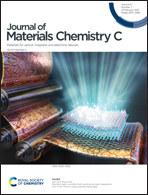Surface organic ligand-passivated quantum dots: toward high-performance light-emitting diodes with long lifetimes†
Abstract
For quantum dot light-emitting diodes (QLEDs), typical colloidal quantum dots (QDs) are usually composed of a core/shell heterostructure which is covered with organic ligands as surface passivated materials to confine the carriers in QDs and prevent the agglomeration and growth of QDs. To enhance the electroluminescence (EL) performance of QLEDs, capping ligand modified QDs were synthesized to improve the QD passivation and stability as well as luminance efficiency. Here, short thiol-based ligands (1-dodecanethiol (DDT) and 1-octanethiol (OT)) are used to investigate the surface organic ligand effect on device performance. Moreover, the QDs with shorter OT ligands (OT-QDs) show efficient passivation and achieve high photoluminescence properties. The QLEDs based on OT-QDs achieve an improved overall charge balance in LEDs and a maximum EQE over 25%. An operational lifetime (T50) over 420 000 h is obtained for OT based QLEDs, which is a 3.42-times enhancement compared to DDT based QLEDs. This work highlights the potential of thiol-based ligands for the surface passivation of QDs, for improved stability as well as performance in QLEDs.



 Please wait while we load your content...
Please wait while we load your content...